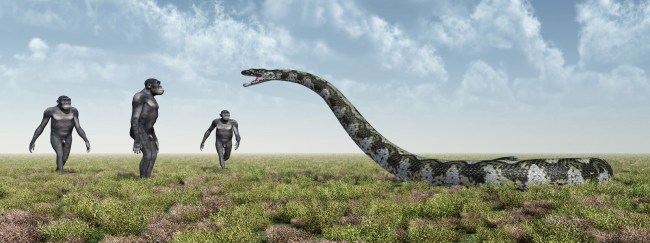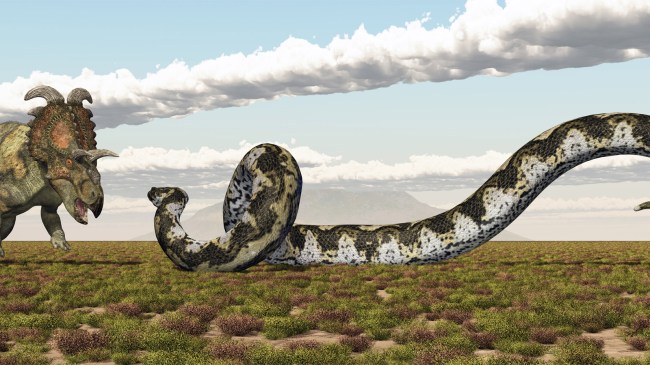iStockphoto
The largest known species of snake to ever exist is Titanoboa (pictured above). Or, well, it was.
Now, a new species of prehistoric snake named Vasuki indicus may have taken over the top spot.
That’s because scientists in India recently discovered the fossilized remains of an ancient snake that by their measurements comes in at around 50 feet (15.2 meters) long.
Named after the mythical “king of serpents” in Hinduism that wraps itself around the neck of the Hindu god Shiva, it was discovered in the Panandhro Lignite Mine.
The 27 vertebrae recovered from the mine has scientists believing that Vasuki indicus was even larger than Titanoboa, which was approximately 42 to 46.9 feet in length.
“Vasuki belongs to an extinct family of snakes, distantly related to pythons and anacondas, and so when you’re using existing snakes to estimate body length, there may be uncertainties,” study co-author Debajit Datta, a postdoctoral researcher at the Indian Institute of Technology Roorkee, told Live Science.
The scientists believe the Vasuki roamed the planet around 47 million years ago during the Eocene epoch when average temperatures were around 82.4 degrees Fahrenheit.
Titanoboa, a monstrous boa constrictor, lived approximately 60 million years ago in South America.

iStockphoto
“The most important finding of our study is the identification of an exceptionally large snake, which not only adds to the existing knowledge of madtsoiid snakes but also adds to the known diversity of snakes from the Cenozoic of India,” said Sunil Bajpai, a vertebrate paleontologist at the Indian Institute of Technology Roorkee and co-author of the study, in an email to Gizmodo.
By comparison, the current Guinness world record for longest snake in captivity ever was a reticulated python the measured 25 feet, 2 inches.
“As Vasuki was terrestrial/semi-aquatic, it is possible that this extinct snake preyed on a variety of animals similar to modern-day pythons,” Datta and Bajpai told IFLScience.
“It is difficult to say at this point precisely what sort of animals Vasuki preyed upon. However, it is to be noted that associated fossils of rays, sharks, catfish, turtles, crocodiles, and primitive whales were found in the same rock unit that yielded the remains of Vasuki. No land mammals were found.”

